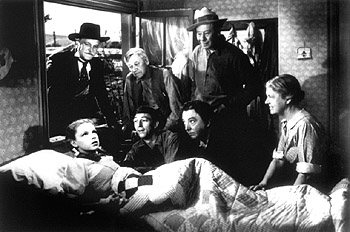I remember writing a defense of the movie Hook when I was pretty young. It came about when I noticed that there were all sorts of online reviews claiming the movie was an inferior piece of work, poor form on Spielberg’s part, “why is Julia Roberts Tinkerbell,” the list goes on. I couldn’t really understand the problem: if you’ve read or watched any version of Peter Pan, the boy who never grew up, there was always a part of you that wondered…but what if he did? Hook was a loving testament to that thought, and I adored it.
But in the end, the argument I chose to make was far simpler: this movie was for people who believed in Neverland. Not people who were overly concerned with continuity and casting choices and the fact that the Lost Boys were now on skateboards (which made perfect sense, by the way). This movie was for people who believed that Neverland was a tangible place, something they could reach whenever their heart was searching for some time to play.
How many of us believe that, I wonder? Because, as we’re often taught in our childhood stories, these places don’t exist. They’re just a dream. A hallucination. Our young, malleable minds trying to make up for what we don’t understand by creating something fantastical. It used to make me angry. In some ways it still does.
Why can’t Neverland be real?
Outside of The Chronicles of Narnia, nearly every well-known children’s story ends on the same note. The kid wakes up or turns around finds that they are home. Their adventures in another land equip them to handle a situation that they did not have the capacity or awareness to deal with beforehand. Everything is right in the world. The end.
In the film version of The Wizard of Oz, Dorothy wakes up and finds herself at home and surrounded by her family. They insist that this dream she had about Oz is the result of a little bump on the head; credence is given to their side of events when you see that nearly everyone in Dorothy’s “dream” looks exactly like someone from the real world. Either way, it’s not that important—Dorothy came to realize on her journey that all she really wanted was to be home, and home is where she is.
In Labyrinth, Sarah learns valuable lessons about growing up: that life isn’t always fair, that it’s important to be true to your friends, and most of all, that no one has power over her. She defeats the Goblin King and his kingdom shatters around her. Then she’s suddenly—yeah, you guessed it—back home. At the end, she sees her friends from the labyrinth reflected in a mirror. They reassure her that if she ever needs them, she only needs to call. The metaphorical point here seems clear—that we all need to return to the fantasies of childhood sometimes and appreciate what they have given us. Similarly to Wizard of Oz, most of the figures Sarah encounters in her imaginary world are dolls and stuffed creatures found in her room.
Versions of Alice in Wonderland have done the same, though Tim Burton gets some extra credit for the fact that his Alice continues believing in Wonderland after her story there has completed. Pan’s Labyrinth deals in the same tropes as well, and that may be the hardest of all these tales to swallow. Because if this world where Ofelia is a princess isn’t real, then the truth of that film becomes almost impossible to stomach.
Even the world of Neverland is supposed to exist in the minds of children. While J.M. Barrie may have had faith in the reality of that place, your average adult is not going to view it the same way, and that will affect how it is passed down to children. In some ways, even Narnia is guilty of this; Christian allegory aside, the Pevensie’s learn in The Last Battle that they aren’t in the real Narnia. All that they had accomplished in that world ended up being nothing more than a primer for something else.
Yet Tolkien never pulls us out of Middle-earth to remind us that he made it up. Wart doesn’t turn around and discover that Merlin was his mind’s way of preparing him to be a great leader in The Once and Future King. Certainly no one is ever going to create a version of Beowulf where the great hero awakes and finds that he has been dreaming about Grendel the whole time.
While I understand why no parent is keen on letting their child believe that glitter and happy thoughts will make them fly (there are warnings on Superman costumes for a reason), I don’t understand why there is an insistence across the board that all of these places must be the product of a fever dream. Magic is magic. You can’t pare it down with clever tricks of the mind and a mild concussion. These stories are only as powerful as our belief in them. It seems a shame to try and convince your core audience otherwise.
Then again, kids are going to believe what they want. Just because you say that the Tin Man is really Hickory doesn’t mean they buy it. In fact, that might be the whole point; maybe those moments where they claim that you were just sleeping the whole time…maybe that’s for all the jaded adults who would never believe it otherwise.
Guess I better keep believing in Neverland. I sure don’t want to end up like that when I’m all grown up.
Emmet Asher-Perrin still gets called out by her friends on assuming “the Peter Pan stance” whenever she’s feeling stubborn. You can bug her on Twitter and read more of her work here and elsewhere.










